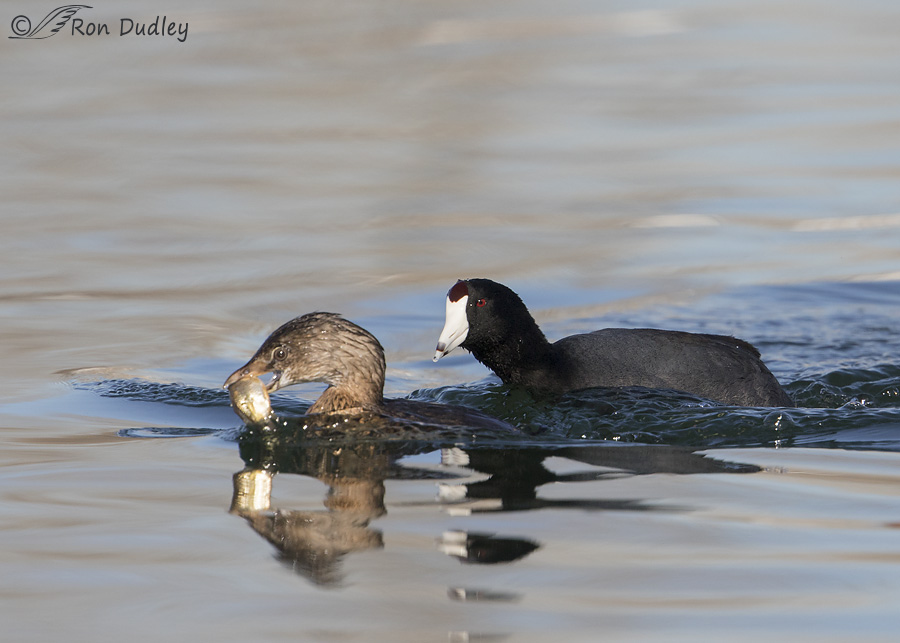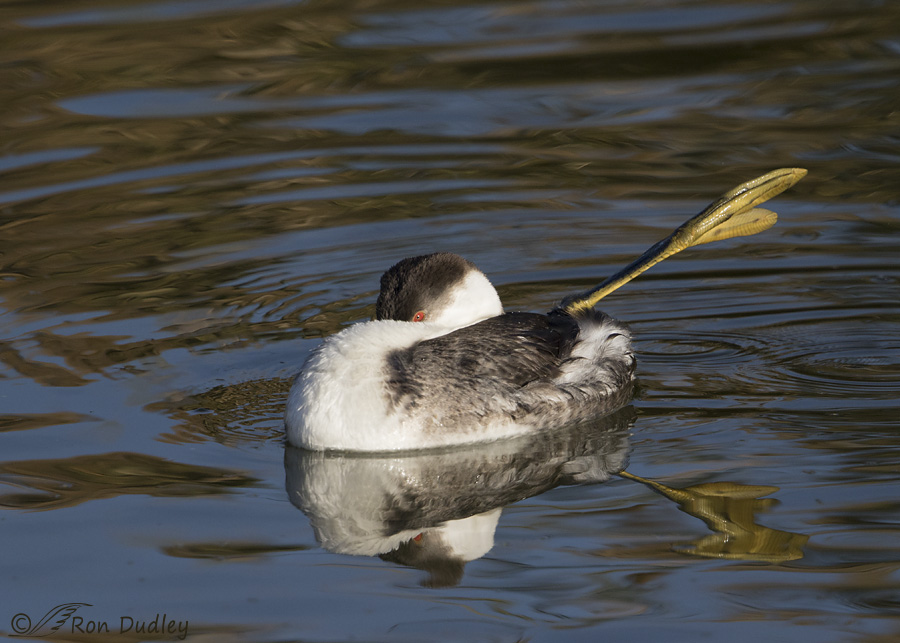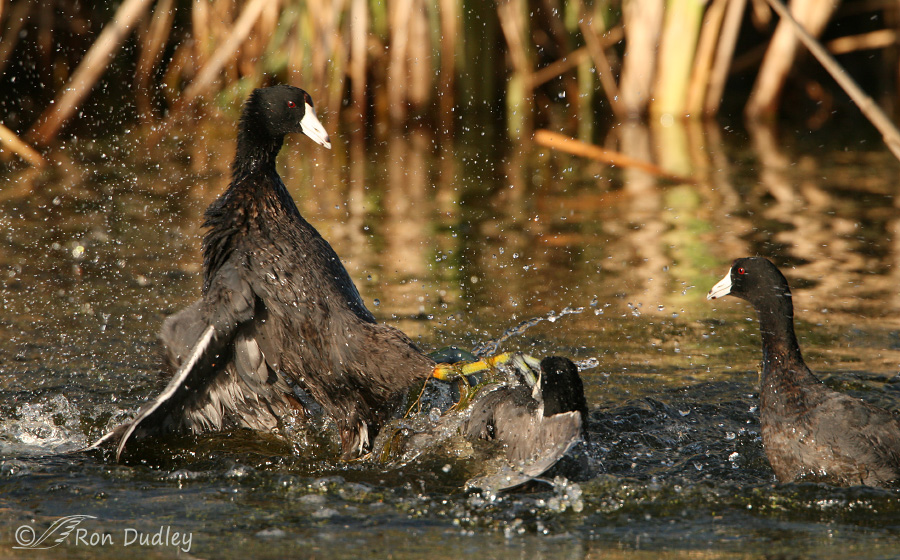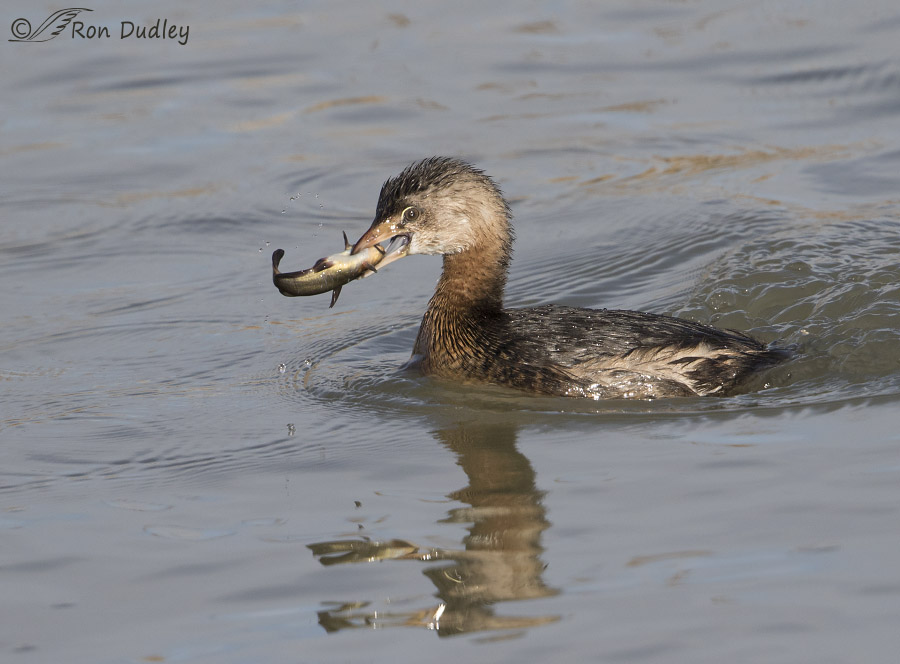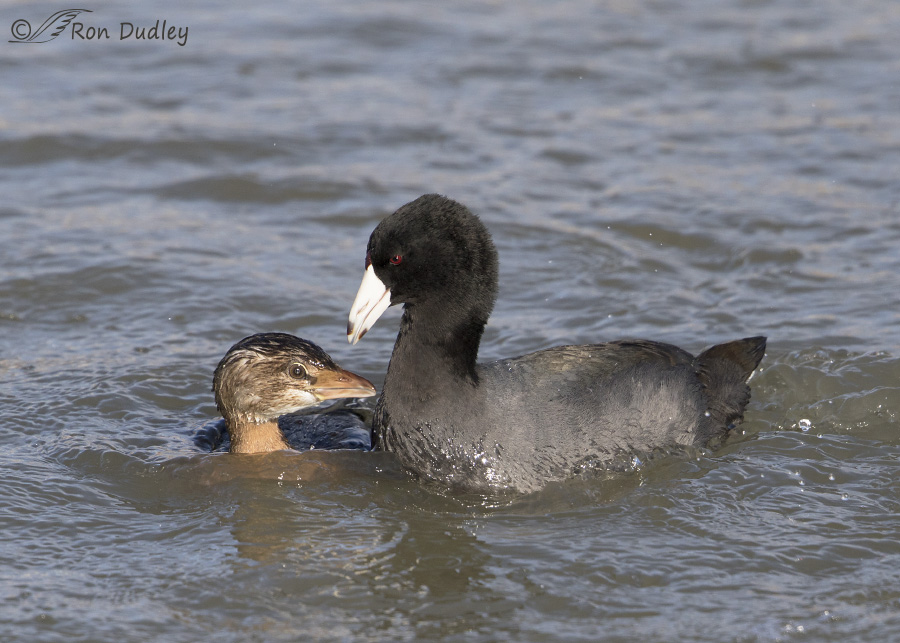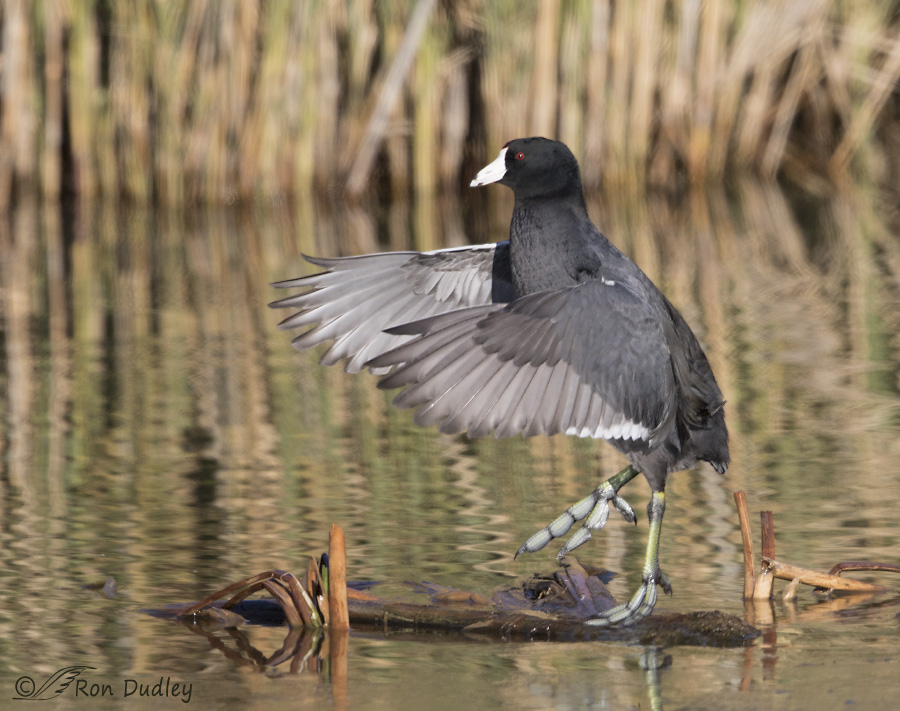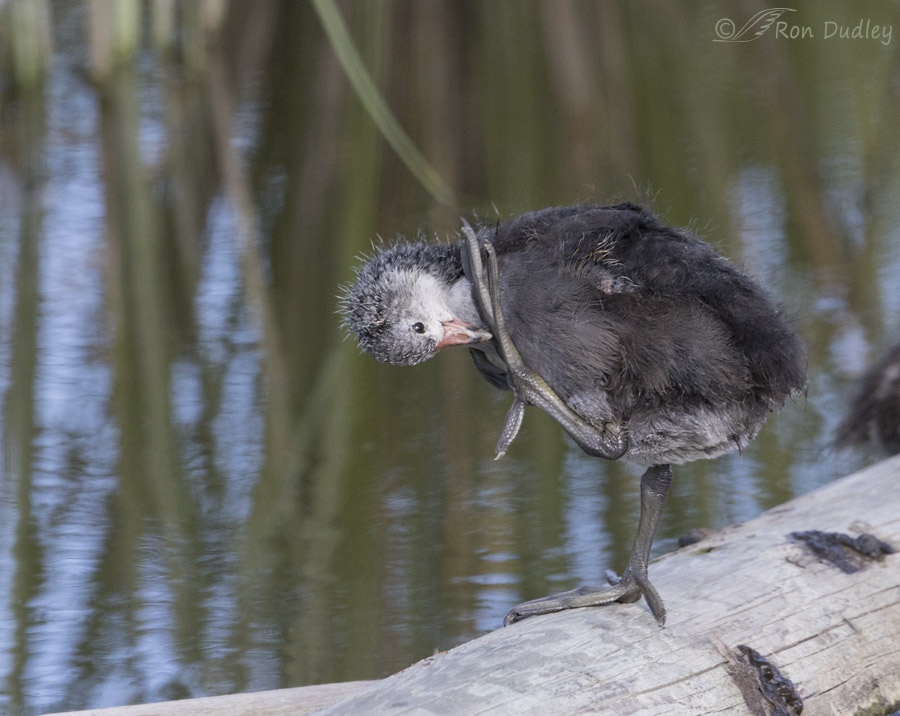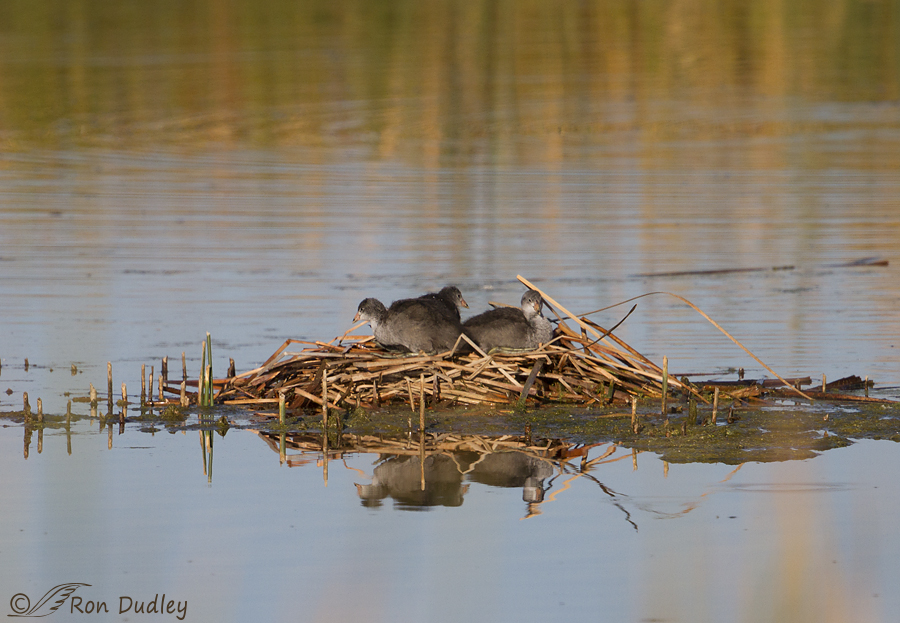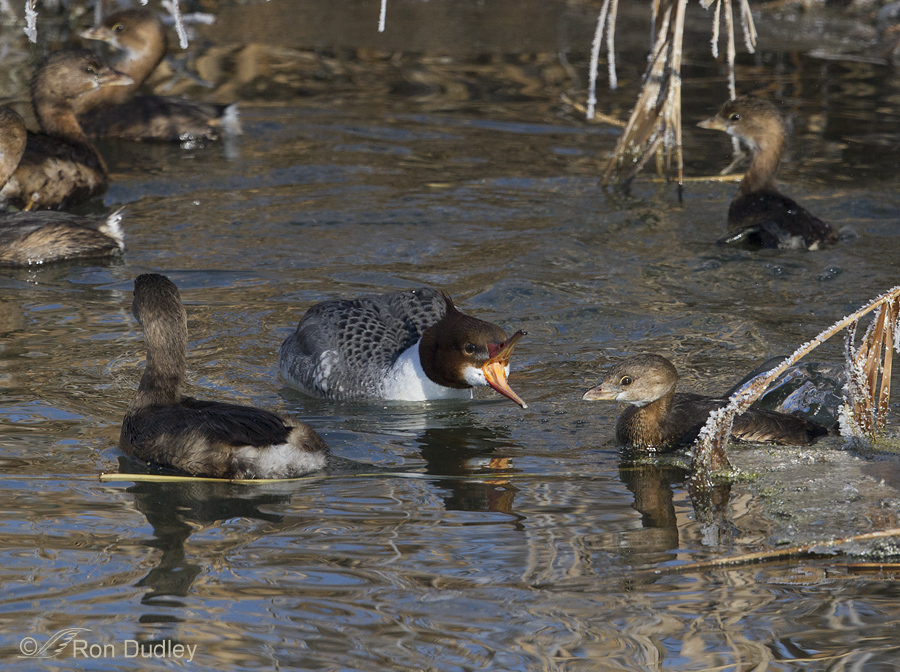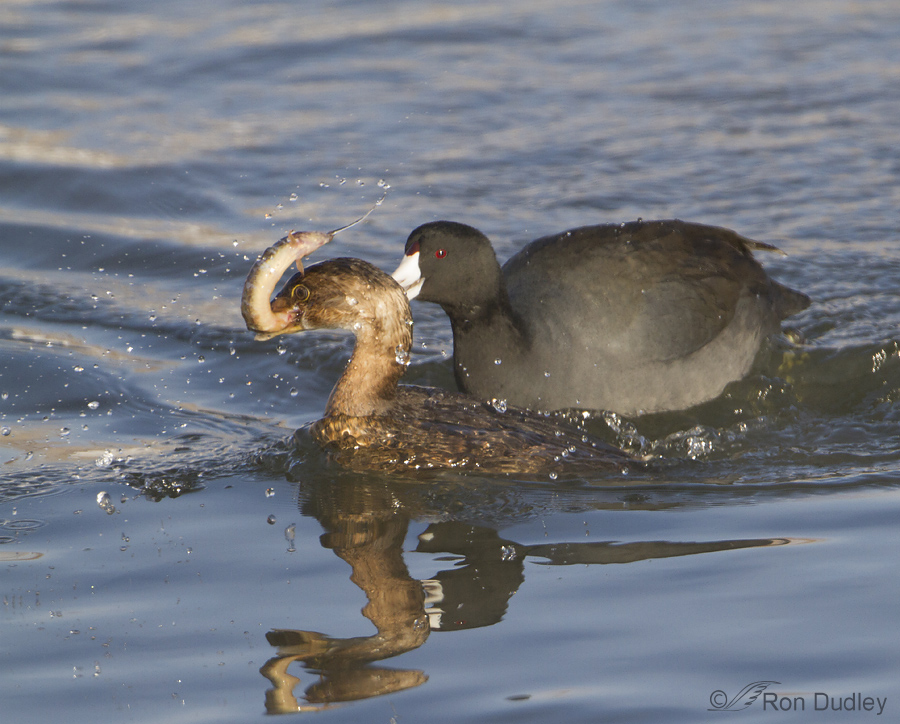Tag: american coot
A Potpourri Of Recent Images (8 bird species and 1 mammal)
The Events And The Birds That Hooked Me On Bird Photography
A Grebe And A Coot Battle Repeatedly Over A Fish
A Grebe And A Coot – What’s Going On Here?
High Steppin’ Coot
Young Coot Giving Its Huge Foot A Pedicure
Have You Seen Birds Nesting This Late In The Season? I Just Did…
Pond Dramas
A Coot In Pursuit Of A Grebe’s Fish
Gadwall Stealing Food From A Coot
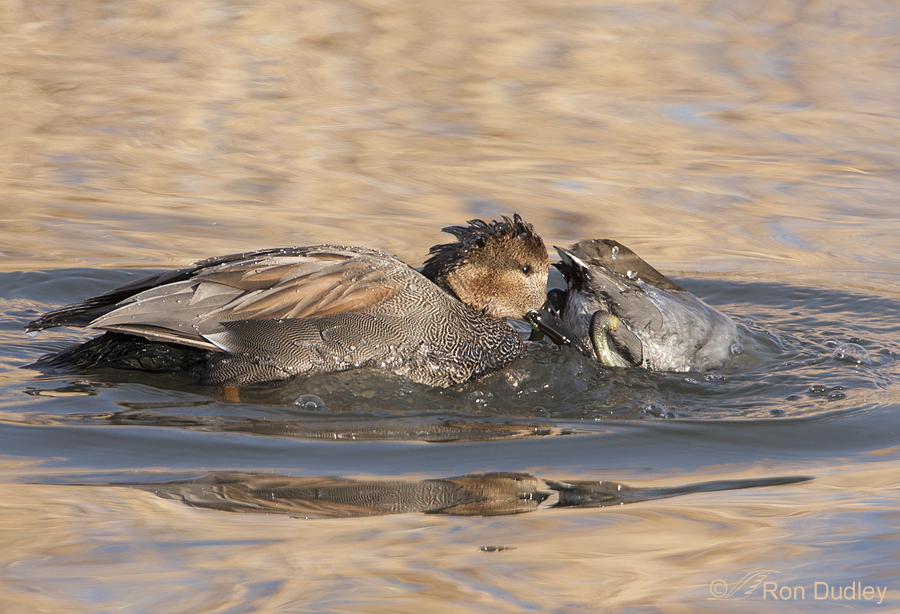
Gadwalls are well-known for stealing food (kleptoparasitism) from American Coots . They eat the same kinds of food (submerged aquatic vegetation), Gadwalls are almost a third bigger than coots and the two species often feed together in mixed flocks so being the bullies on the block, Gadwalls can’t resist taking advantage of the situation.
Coot Running Through Walls Of Water
Coots are quarrelsome, belligerent and cantankerous, especially the males in springtime before the females lay their eggs. Sometimes weaker combatants are killed.
Coots Don’t Like Redheads
Last spring I witnessed quite the little drama between an American Coot and a mated pair of Redheads. I’m going to be a little anthropomorphic here with my narrative (and even my title) – sorry, just can’t resist. The Redheads seemed to be minding their own business but this coot took exception when they came too close to its nest. Here the coot is apparently looking away from the ducks but the Redheads seems to know that something’s potentially up. And it was. I’m always amazed at how fast the reactions of birds are. The Redhead almost seemed to know the attack was in progress before it actually was. You’ll notice that the coot is no closer to him in this second shot than it was in the previous one. The Redhead seems to be trying to use some of the reeds to avoid the approaching coot. The attack continues… and continues… until both birds sense that it’s over and begin to settle back down into the water. The male Redhead reacts with what seems like a celebratory wing-flap that it survived the attack without any damage… and then swims off contentedly with his lady. But the coot isn’t taking any chances and lays low in the water while facing the retreating ducks with a threat pose. I was pleased to get this sequence without clipping any birds and keeping multiple subjects sharp in the frame – not easy to do…
Harlan’s Hawk On A Coot Kill (graphic)
On January 18 I photographed this Harlan’s Hawk at Farmington Bay WMA. Harlan’s is a relatively rare and very dark subspecies of the Red-tailed Hawk that breeds in Alaska and northern Canada but winters in the western U.S. and the Great Plains. I posted two other shots of this bird on January 20. 1/3200, f/7.1, ISO 400, 500 f/4, 1.4 tc, natural light, not baited, set up or called in On this day I only had a few moments with the hawk before it took off. 1/2500, f/8, ISO 500, 500 f/4, natural light, not baited, set up or called in Then, on January 22, we located the bird once again within just a few yards of where it had been four days earlier. This time it was at the bottom of a creek gully feeding on a freshly killed American Coot. The angle was steep and it’s not the most attractive setting but the behavior was interesting so I took lots of photos of this juvenile, if for no other reason than documentation of an unusual bird enjoying a meal. 1/2500, f/8, ISO 500, 500 f/4, natural light, not baited, set up or called in The bird was only nervous with our presence for a few moments, then resumed eating its meal with enthusiasm. Here it has a beak-full of feathers that it had a difficult time shaking off. 1/2000, f/7.1, ISO 500, 500 f/4, natural light, not baited, set up or called in I spent over 5 minutes with this…
It’s Been A Tough Winter For Birds (and it’s getting worse)
Typical winters are hard on birds in northern Utah (and elsewhere). But when the season is unusually frigid with lots of snow as we’re having this year they struggle even more to survive. All of these images have been taken since January 2 of this year. Upland game birds like this Chukar seem to have adapted to extreme conditions fairly well. This bird was all puffed up and sitting high on a rock to catch the earliest warming rays of the sun as it rose over the nearby Wasatch Mountains. Another upland game species that can apparently take harsh conditions quite well is the Ring-necked Pheasant (this is a female). They seem to forage for seeds at the base of plants where the snow isn’t as thick and their food is more readily available. But many other species have a difficult time and quite a few birds don’t survive until spring. The waterfowl that winter over here congregate in the few areas of open water where the flowing water is the last to freeze over. But when it gets very cold, even those small bits of open water freeze. I’ve seen ducks and coots frozen into the ice, some of them still alive. This female Green-winged Teal has just left one of the last unfrozen patches of water and is approaching an area of frost flowers. This Northern Flicker is using the protection of the underside of the eaves of a building on Antelope Island State Park. I thought the angled…
A Potpourri Of Recent Images (8 bird species and 1 mammal)
The Events And The Birds That Hooked Me On Bird Photography
A Grebe And A Coot Battle Repeatedly Over A Fish
A Grebe And A Coot – What’s Going On Here?
High Steppin’ Coot
Young Coot Giving Its Huge Foot A Pedicure
Have You Seen Birds Nesting This Late In The Season? I Just Did…
Pond Dramas
A Coot In Pursuit Of A Grebe’s Fish
Gadwall Stealing Food From A Coot

Gadwalls are well-known for stealing food (kleptoparasitism) from American Coots . They eat the same kinds of food (submerged aquatic vegetation), Gadwalls are almost a third bigger than coots and the two species often feed together in mixed flocks so being the bullies on the block, Gadwalls can’t resist taking advantage of the situation.
Coot Running Through Walls Of Water
Coots are quarrelsome, belligerent and cantankerous, especially the males in springtime before the females lay their eggs. Sometimes weaker combatants are killed.
Coots Don’t Like Redheads
Last spring I witnessed quite the little drama between an American Coot and a mated pair of Redheads. I’m going to be a little anthropomorphic here with my narrative (and even my title) – sorry, just can’t resist. The Redheads seemed to be minding their own business but this coot took exception when they came too close to its nest. Here the coot is apparently looking away from the ducks but the Redheads seems to know that something’s potentially up. And it was. I’m always amazed at how fast the reactions of birds are. The Redhead almost seemed to know the attack was in progress before it actually was. You’ll notice that the coot is no closer to him in this second shot than it was in the previous one. The Redhead seems to be trying to use some of the reeds to avoid the approaching coot. The attack continues… and continues… until both birds sense that it’s over and begin to settle back down into the water. The male Redhead reacts with what seems like a celebratory wing-flap that it survived the attack without any damage… and then swims off contentedly with his lady. But the coot isn’t taking any chances and lays low in the water while facing the retreating ducks with a threat pose. I was pleased to get this sequence without clipping any birds and keeping multiple subjects sharp in the frame – not easy to do…
Harlan’s Hawk On A Coot Kill (graphic)
On January 18 I photographed this Harlan’s Hawk at Farmington Bay WMA. Harlan’s is a relatively rare and very dark subspecies of the Red-tailed Hawk that breeds in Alaska and northern Canada but winters in the western U.S. and the Great Plains. I posted two other shots of this bird on January 20. 1/3200, f/7.1, ISO 400, 500 f/4, 1.4 tc, natural light, not baited, set up or called in On this day I only had a few moments with the hawk before it took off. 1/2500, f/8, ISO 500, 500 f/4, natural light, not baited, set up or called in Then, on January 22, we located the bird once again within just a few yards of where it had been four days earlier. This time it was at the bottom of a creek gully feeding on a freshly killed American Coot. The angle was steep and it’s not the most attractive setting but the behavior was interesting so I took lots of photos of this juvenile, if for no other reason than documentation of an unusual bird enjoying a meal. 1/2500, f/8, ISO 500, 500 f/4, natural light, not baited, set up or called in The bird was only nervous with our presence for a few moments, then resumed eating its meal with enthusiasm. Here it has a beak-full of feathers that it had a difficult time shaking off. 1/2000, f/7.1, ISO 500, 500 f/4, natural light, not baited, set up or called in I spent over 5 minutes with this…
It’s Been A Tough Winter For Birds (and it’s getting worse)
Typical winters are hard on birds in northern Utah (and elsewhere). But when the season is unusually frigid with lots of snow as we’re having this year they struggle even more to survive. All of these images have been taken since January 2 of this year. Upland game birds like this Chukar seem to have adapted to extreme conditions fairly well. This bird was all puffed up and sitting high on a rock to catch the earliest warming rays of the sun as it rose over the nearby Wasatch Mountains. Another upland game species that can apparently take harsh conditions quite well is the Ring-necked Pheasant (this is a female). They seem to forage for seeds at the base of plants where the snow isn’t as thick and their food is more readily available. But many other species have a difficult time and quite a few birds don’t survive until spring. The waterfowl that winter over here congregate in the few areas of open water where the flowing water is the last to freeze over. But when it gets very cold, even those small bits of open water freeze. I’ve seen ducks and coots frozen into the ice, some of them still alive. This female Green-winged Teal has just left one of the last unfrozen patches of water and is approaching an area of frost flowers. This Northern Flicker is using the protection of the underside of the eaves of a building on Antelope Island State Park. I thought the angled…


